Susan Hunter's Blog, page 9
January 2, 2017
Things I Didn’t Say
[image error]Due to some forced down time because of a nasty cold, I’ve been lying on the couch doing a lot of TV watching. My intent was that my mind would drift aimlessly, while my body was in recovery mode. Instead, I’ve found myself confronted with an uncomfortable amount of self-reflection, inspired by a couple of shows I’ve seen.
First, I binge-watched a series on Amazon, Good Girls Revolt. It’s the story of a group of female researchers for a national magazine in the 1960s, who are not allowed to do the “man’s work” of reporting the news. Regardless of education or experience, they are relegated to positions as researchers. “Girls” can’t be reporters at the publication. But a few brave souls push back. They speak up, and they speak out. When management remains unmoved, the women risk their current jobs, their future careers, and, in some cases, their relationships, to take the issue to court.
The plot is a fictionalized account of a true story that unfolded at Newsweek magazine. Thanks to those women and others like them, by the time I really got started in my career, the rules had changed. But in many cases, attitudes hadn’t. As I watched the series, it made me think about the times at work–and in life–when I could have spoken up, either for myself or others, but I didn’t, because it wasn’t my fight, or it was uncomfortable, or I was afraid to risk my job.
Then I watched an old movie that set off another bout of self-assessment. Filmed in the late 1940s, Gentleman’s Agreement is about a reporter who pretends to be Jewish, in order to write a story about antisemitism. A character in the film argues that she’s not prejudiced, that when a friend at a dinner party told a derogatory “joke” about Jews, she didn’t laugh, and neither did any of the other “nice people” at the table. The man she’s speaking to responds in a way that prompts her to see the issue in a different light. “A man at a dinner table told a story, and the nice people didn’t laugh. They even despised him, sure. But they let it pass.” She has a moment of clarity and realizes that’s how bigotry is normalized–when nice people say nothing, because it’s too uncomfortable or “impolite” to do so.
I’ve decided that it’s not the things I’ve said that plague my conscience the most–though my reflexive need to give a fast and funny response often gives me plenty of cause for remorse. No, it’s the things I should have said, but didn’t, because it would have been awkward or unpleasant, or difficult, that cause me the most regret.
Last year, my goal was to be more careful with my words, not to substitute a clever comeback for real empathy and understanding. For me, I’m afraid that will remain a lifelong aspiration. But I’m adding a companion resolution to it this year, to try to follow the wise counsel of a Catholic bishop I once interviewed.
“Ask yourself, is it true? Is it your truth to tell? And, can you tell it with love? If your answer is yes, then do it.”

December 19, 2016
This One’s For You, Aunt Helen
[image error]The holidays are a natural time for looking back, but I was struck today by how the unremarkable objects of everyday life can stir a flood of memories any day of the year.*
Whenever I make a cup of tea and drop in an ice cube to bring it to drinkable temperature, I think of my husband’s Aunt Helen. For years I either scalded my throat with too-hot tea, or downed disgustingly tepid brews I had set aside to cool, and then forgot.
Until one day, when I made a cup of tea for Aunt Helen, and she asked me to put an ice cube in it. Sad, but true, that simple remedy had never occurred to me. But now whenever I use it, I think of Aunt Helen and remember not just her advice on tea, but her warmth, her laugh and the pleasure of her company.
The same holds true when I see a piece of chunky jewelry, particularly a bracelet with lots of beads and bangles. I immediately see my Aunt Barb, who liked to relax around the house in her night-time wear well into the afternoon, but always with her hair carefully coiffed, clip-on earrings in place and big, chunky jewelry on her wrist. And that leads me to remember not just her at-home fashion wear, but her extroverted personality, her wonderful cooking and her salty take on life.
The smell of paint and varnish takes me to my Dad’s garage, sitting on an overturned five gallon paint can, watching him refinish a piece of furniture, or repair a broken chair, or repurpose a discarded household object. He listened to me chatter, all the while working with large but gentle hands, preserving what was straight and true, smoothing out the rough spots, filling in the holes, creating something good that would be of use in the world. He did the same thing for all of his children, raising us with strength and kindness, helping us to see the value in things and in people, even when their surfaces are battered and broken. To me, paint and varnish still smell like love.
On Christmas this year I will eat a Santa Claus cookie made by my sister Barb, who bakes and decorates them just the way our mother used to. And of course I will think of Mom. How she painstakingly frosted the finely detailed cookie with an artist’s hand — dots of blue for the eyes, a smiling red mouth and bright spots of red for cheeks and nose, a white beard with a sprinkling of coconut. I will remember how she always held back a few with plain frosting for my sister Tricia, who hated coconut. And I will think of all the times Mom took the trouble to make things just right for each of us, in all kinds of ways and situations.
When I’m cooking, I never mince a clove of garlic without remembering my friend Irene and how she cultivated everything — her garlic crop, her flowers, her friendships, her family — with joy. I think of her gentle nature and her loving heart and I miss her. But I am so thankful that I had the happiness of knowing her.
I hope this year to spend more time building good memories for the people that I love. I hope you do, too.
*This blog first ran two years ago, but I was asked to repeat it this season.

December 8, 2016
A Clean Finish
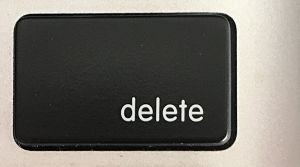 This is the season when I marvel at how fast the months have gone, take stock of goals I set so confidently when the year was new, and reflect sadly on how few of them actually came to fruition. “Between the idea and the reality…falls the shadow.”
This is the season when I marvel at how fast the months have gone, take stock of goals I set so confidently when the year was new, and reflect sadly on how few of them actually came to fruition. “Between the idea and the reality…falls the shadow.”
I didn’t do yoga three times a week…or two times…or one time; I didn’t prepare a healthy meal from scratch every night…or every third night…or every week; I didn’t finish reading Moby Dick; I didn’t learn to parallel park. But this time, instead of surrendering to guilt and regret as December closes in, I decided to pick one thing from my to-do list for 2016. Working with diligence and focus, I would get that one thing done–probably in just a few hours, or a day at most, of concentrated effort.
To my great regret, I chose cleaning off my computer as the task to which I would give my last full measure of devotion before year’s end. My hard drive is filled with the accumulated detritus of more than a dozen years, because each time I switched to a new machine, rather than get rid of what I didn’t need, I simply transferred everything over.
With a new computer expected shortly, there seemed no better opportunity than now to tackle the long-deferred task of digital clean-up. Upon completion, I could work on my new book, on my new computer, in a brand-new world of organized files.
My first mistake was in thinking it would take only a few hours to purge the clutter of a dozen years. I’ve been working on it for four days now, with no end in sight. I have entered a nightmarish landscape of outdated, mislabeled, and incomprehensibly named folders. Within those folders are random files, unused applications, memos from my time as a college administrator, letters to no-longer-serving congressmen, and research on illnesses I decided I might have after watching House. Apparently, I never met a PDF I didn’t want to download, or a website I didn’t feel the urge to bookmark.
In other words, working my way through my hard drive is like trying to clean out 10 junk drawers, inside 10 other junk drawers, inside 10 other junk drawers. My computer is the digital equivalent of Russian nesting dolls, if the dolls are composed of multiple drafts of the same chapters, old resumés, and contact information for people I don’t remember.
I’ve had my quarrels with paper files over the years, but at least they don’t multiply like the brooms in Fantasia when my back is turned. The same can’t be said for digital files, which have the opposite problem of socks in the dryer; instead of coming out with one of a pair missing, I end up with duplicate versions of things I barely need one copy of–or so it seems.
And now, as I enter Day 5 of decimating my digital files, I’ve reached that dangerous point, wherein I don’t really care if it’s the last living copy of something I might really need later, I just want it gone. I’m deleting things with wild abandon. Yet I have a lingering fear that the image below may turn out to be a metaphor for the future me, searching in vain through my digital trash bin for the one file that I actually, really, truly, can’t replace. But at the moment, the mission is all, and I’ll deal with the consequences later.

What’s done, is done.

November 22, 2016
Readers Write

Everyone has an opinion.
Writing is a solitary job. Just you and a blank computer screen that isn’t a lot of company, especially when it stays stubbornly blank for a discouraging amount of time. But when you finally finish and publish your work, you get the chance to connect with readers. Sometimes what they write is warm and kind. Sometimes it’s not. But it’s always interesting to hear the perspectives of people who have spent some time in the fictional world you create.
Over the past few years, I’ve discovered that book reviews are a little like getting a performance evaluation from hundreds of people, in front of an audience of thousands. Sometimes it’s good, sometimes it’s bad, and sometimes it gets a little ugly. In the spirit of the Jimmy Kimmel Live segment “Mean Tweets,” here is a sampling of what readers (none of whom I know) write about the Dangerous Mysteries series. (I’m including the good first, because I don’t want to scare any potential readers away by leading with the bad)!
First, the good:
Everything a mystery should be.
I stayed up until three in the morning to finish reading this book.
For a fascinating read you can’t put down, I highly recommend this writer.
Lots of twists and turns and great character descriptions.
Wow, what a read!!! I loved this book.
Next, the bad:
Disappointing: lack of character development ruined this story.
This novel felt like the story arc in a daytime soap opera.
No character development.
Juvenile. Kind of like “Lois Lane,” girl reporter.
Run of the mill. Bought by my wife, so perhaps it is a book aimed at female readership. (And we all know that females enjoy run of the mill stories? Sorry, couldn’t resist a little editorializing. SH)
And then, the ugly:
Ughhhh. Boring, dragged on, poor choice of story line.
The author took a good plot and over complicated it to the point of ridiculous[sic] and boredom.
Good mystery. Terrible writing.
I kept falling asleep because the book couldn’t hold my interest.
After reading this book for hours a day I almost thought I was never going to finish.
Actually, I feel very fortunate that the books I’ve written have engaged readers enough to motivate them to comment, for good or ill, on the story and characters in the series. It would feel quite awful to put something out there, and never get a reaction at all.
It would be nice if every reader enjoyed everything I wrote, but I know that you can’t please all of the people all of the time—and reviews have taught me that you can’t please some of the people any of the time. Still, the good ones lift my spirits and make me smile, the bad ones inspire me to try harder, and the ugly ones make me laugh out loud.
Now, in this season of giving, if you have the time or inclination, please post a review or send an email to let an author know you enjoyed her or his books. And I don’t mean mine. I’m speaking here for all the solitary writers tapping away at their computers, and/or tearing their hair out and wondering if what they are writing is ever going to touch anyone reading it. It would be a very nice gesture to let them know it has.
October 27, 2016
Crafty Words
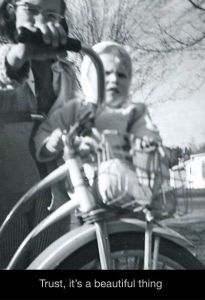
Me and my sister
I’ve written before about my limited, nay, let’s call it what it is, my nonexistent ability to measure accurately, draw straight lines, use scissors or employ any of the other skills needed to successfully create a beautiful, useful, or display-worthy handmade object.
But today, I’m about to share with you something that I can do, and you can, too. You can make personalized cards for family and friends that are funny, touching, embarrassing or all three, depending on the occasion, your relationship, and your inclination. All you need is a collection of photos, a computer, an internet connection and a little time.
The lead picture on this post is a birthday card I made for my sister Mary Kay. I don’t remember the occasion of the photo, but it strikes me as very ill-advised. I can only surmise that either our mother did not truly have the love she professed for my younger sister, or that I had taken it upon my eight-year-old self to pop her into my bike basket for a quick ride. Clearly, my sister had some reservations but little power to do anything about them. I’m happy to say she survived to enjoy the birthday card many years later.
This is a card I made for my brother, from one of his favorite photos.

Jim’s birthday
I include it primarily to curry favor, because he gave me grief for writing a post about my sisters awhile ago.

Blake’s graduation
Here’s one I did for my nephew when he graduated from high school.
The point is not to bore you with bits of family history, but to say that though it takes a little time to find the right photo and figure out what you want to say, the actual making of the card requires no special skills. And the end product is so much nicer than the $3 or $4 or $5 card you bought at the store that doesn’t quite say what you want it to, but it’s all you could find.
If you have a Mac, it’s super easy to make a card. You just select a photo from your photo library, click on “create a card,” drop it into the pre-formatted layout of your choice and come up with the words you want to say. You can use more than one photo, and you can choose to make a card with no text on the front or inside. However, I always have a lot of words I want to say, so I always choose the text option both on the cover and inside. Once it’s done, you can order it online and get it within a few days.
I don’t know if a similar program is available on PCs, but I do know there are sites like Mixbook, Snapfish and others on the Web that let you do the same thing. You just upload your pictures, choose your layout, write your text and there you go.
I’m not typically an advocate for DIY projects, because in my experience, things can go very, very wrong. However, this is something that is really fun to do, and so easy that even I can do it. The card you make is really a gift in and of itself, because you’re giving your thoughts, your time and your love. It’s a very fun way to use your words.
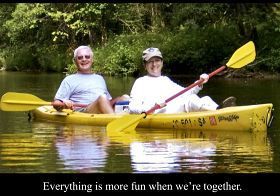
Anniversary Card

October 13, 2016
It’s getting closer …

Coming in November!
Usually I try to write a post about something interesting, useful, thoughtful or funny. But be forewarned. Today I write about frustration, darkness, fear and loathing. Today I write about getting my third book Dangerous Places ready for publication.
One might think, this being the third time I have gone through the process, that I would have developed a system, a method, an easy-peasy, one-two-three for moving from final draft to finished product. Alas, it is not so. But not for lack of trying. I contacted a designer well in advance of the date by which I would need a cover for book three. However, I failed to factor in that I actually needed three covers. I changed the format for the new book, which meant the first two covers needed redoing to keep the series looking consistent.
So I unwittingly added untold hours to the design process searching through thousands of stock photos for suitable cover pictures. My lack of an artist’s eye has never been more apparent than in the volume of unusable choices I submitted for consideration before finding a candidate for each book that the designer could work with.
I assured myself that was a minor setback. I forged ahead to the next step, making changes to what’s called “the back matter” of the books—the author bio, contact information, book club questions, etc. At the same time I made those changes, I also used input from kind and alert readers to find and fix typos, missing words or punctuation errors in the first two books. The quest for the elusive error-free book is never-ending. Everything went swimmingly—for a time. Then I made a serious error.
I did not consider the need for extreme focus when uploading new content for two separate books, with similar names, at roughly the same time. Long-time readers acquainted with my predilection for disasters will guess what happened. Yes, it’s true. I came milliseconds away from publishing the copy for Dangerous Habits, the first book in the series, to the file for Dangerous Mistakes, the second book in the series.
But karma apparently let me cash in the chips for some past good deed, because I was saved from disaster by a voice screaming from the depths of my unconscious “Nooooo! It’s the wrong file! Don’t press the publish button!!!” I pulled back from the precipice and avoided having purchasers of Dangerous Mistakes think that I had put very little effort into my second book, since it read exactly like the first.
One of the most challenging things for me in wrapping up a book is writing the “blurb,” the description used in advertising it. I find it very hard to condense a 100,000 word plot down to 100 words. This time I solicited the help of readers who had signed up for the Leah Nash Mysteries update list, and I ran a couple of descriptions by them. I was happily set to use the one they favored, when I discovered it was too long for the space allocated on the back cover.
So, after some serious editing, here is the description for the paperback of Dangerous Places.
A person can’t just vanish. Can she? Journalist Leah Nash investigates the decades-old disappearance of a teenage girl. The stunning answer she finds brings her face-to-face with a shattering secret from her own past—and someone determined to keep it there.
I can use the longer one elsewhere. I’m a little wary about posting it, however, because of a glitch that happened on the GoodReads site last year. My first book had been posted there for more than a year when I happened to check my author page. I noticed that the blurb for Dangerous Habits was no longer correct. To my surprise, the description referred to the lead character as a bisexual Wiccan living in a post-apocalyptic Los Angeles. As you may imagine, the plot outlined was significantly different from the one in my book. I’m not sure how long the description was up before I caught it, or how many readers of the bisexual Wiccan genre purchased my book and were sorely disappointed.
That mix-up was quickly fixed by the helpful librarians at GoodReads, but it remains as evidence in my mind of the perils of publication. However, I am plunging forward ahead despite the dangers. Publication of Dangerous Places is slated for late November.

September 28, 2016
Booked for fun

My author achievement badge
This past weekend I donned my extrovert disguise and briefly lived the life of an outgoing social person who draws her energy from mingling with crowds of her fellow humans, instead of a select few at a time. I attended the Alpena Book Festival, an annual event held on the shore of Lake Huron in the northern reaches of Michigan’s lower peninsula. The weather was lovely, the town was charming and the participants were enthusiastic.
When first invited to participate I said yes, because it seemed like a good way to connect with other writers and readers, and because it was too far away to give me a serious case of introvert’s dread. But as the day drew near, I discovered that multiple other events had found their way onto my September calendar. Every weekend was booked—a dreaded state of affairs for someone who needs alone time. Still, I had promised. So I went, I participated, I got the nametag. And I found it was actually very enjoyable.
About 30 authors were on the schedule for panel discussions, book readings, book signings, and mixing and mingling events with attendees. Funds raised through the festival went to support an adult literacy program. The best part of the activities for me was listening to and learning from writers with a passion for words and their ability to amuse, move, soothe, excite, provoke, change and ultimately connect us with each other. And no, it’s not a paradox that an introvert values connection. We like people just as extroverts do, but in much smaller groupings. And I was able to converse happily with some very nice authors and attendees.
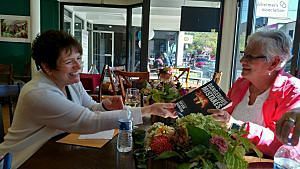
Me, mixing and mingling
I sat on one panel with a friendly, outgoing middle-aged author. Before things began, he told me all about his daughter who had written and published multiple books. His obvious pride in her was so nice to witness that I looked up her books later. I had assumed, because he reminded me so much in looks and demeanor of the dad on Happy Days, that his daughter probably wrote books about cats, or cozy mysteries. Instead, her author page describes her as a writer of “sexy Old West adventures” and erotica. Not that there’s anything wrong with that. It just made me laugh to think of Mr. Cunningham proudly promoting erotica written by Joanie.
I also connected with Robin Devereaux -Nelson, an award-winning author who does it all—she’s an artist, a writer, and a musician. She shared her insights, as well as practical information about tools for writing and the pitfalls of publishing contracts. I picked up one of her books to read, and will reward myself with it when I finally wrap up my own third book. I met another Michigan author, Jenna Mindel, who writes contemporary Christian romance for Harlequin. It’s not a genre I usually read, but I enjoyed hearing her talk about her passion for writing and her commitment to the integrity of her stories so much that I found myself purchasing her book as well. And I even sold a few books myself.
All in all, the Alpena Book Festival turned out to a good experience. I never say no if someone asks me to attend a book club, or give a talk, or participate in an event–at this stage in my writing career, I’m actually grateful for the invitation. And I’ve found that stepping outside my comfort zone can be quite enjoyable. So, I’m happy I went to the Alpena Book Festival. But not as happy as I was to get home, slip out of my extrovert outerwear and into my jammies, and enjoy a nice, long, solo sit in the corner of my couch.
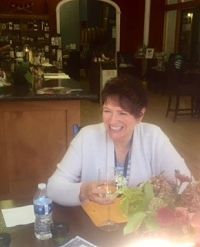
Socializing, introvert style, alone at a table

September 15, 2016
What Price Dignity?
When my youngest daughter was in middle school, we got into a discussion about embarrassing situations we’d each lived through. As we talked, we soon realized that each of us set the bar very differently when measuring the humiliation factor in various situations. From that discussion grew a game we liked to play on our walks together, which we called What Price Dignity?
We presented each other with scenarios with the potential for extreme embarrassment. Then we determined the price we would require before enacting them. The catch was that you could never explain to anyone that the bizarre behavior you exhibited was the result of a bet. Instead, you’d have to live with whatever skewed opinion of you people might have after the incident.
For instance, I might ask her how much money it would take for her to approach her secret crush Kyle Caldecott (names have been changed to protect the dignity of all involved) in the lunch room and say, “You’re the cutest boy in 7th grade.” Her price was $1,000. Mine for the same task was 0.
On the other hand, she might pose a scenario for me that involved breaking into an energetic solo song and dance down the grocery store aisle on a busy Friday night, then simply resuming my shopping with no comment. (As a side note, I have some amazing dance moves to Martha and the Vandellas Heat Wave, but that’s a subject for another post—or perhaps not.)
My price for humiliation in a public place with no possibility of a mitigating explanation was $1,000. My daughter’s for the same action in front of the same audience was $10. While we enjoyed making each other laugh as we upped the ante with increasingly outrageous challenges, the game also gave us a chance to think about the degree to which we live our lives dependent on the opinions of others.
It’s quite natural as an adolescent to crave acceptance from our peers as we take the first tentative steps toward adulthood and away from the security of our family. But even as adults, most of us fall prey at times to our inner critic’s version of the question: What would the neighbors think?
We want to be liked, admired, accepted. We think the way to achieve that is to conform to the norm—whatever that seems to be. We’re afraid to look foolish, to say the wrong thing, to make a mistake. So, we don’t express how we really feel—or who we really are. I’m not advocating total disregard for the conventions of polite society. I’m just saying that our quirky, creative, even contrary impulses are what make us unique. If we never let them out, we never know where they might take us, or what kindred spirits we might find.
If a man loses pace with his companions, perhaps it is because he hears a different drummer. Let him step to the music which he hears, however measured, or far away.~ Henry David Thoreau
Especially if the music he hears is Heat Wave.

September 1, 2016
All in Good Time, My Pretty
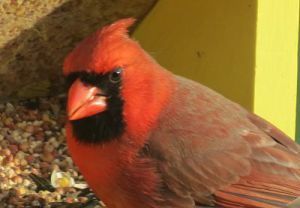 When I was a kid, I’d sometimes go with my father to visit his favorite aunt, Florence. Though lively of mind and loving of heart, her body had begun to fail her and she spent her days in a wheelchair. She was often seated in front of a large window from which she could see the birds who came to feeders in her yard. She’d tell me little stories about their antics and how much pleasure it gave her to watch them. I’d smile politely and murmur something about how that must be fun, but inside I was thinking If watching birds ever becomes my idea of fun, shoot me.
When I was a kid, I’d sometimes go with my father to visit his favorite aunt, Florence. Though lively of mind and loving of heart, her body had begun to fail her and she spent her days in a wheelchair. She was often seated in front of a large window from which she could see the birds who came to feeders in her yard. She’d tell me little stories about their antics and how much pleasure it gave her to watch them. I’d smile politely and murmur something about how that must be fun, but inside I was thinking If watching birds ever becomes my idea of fun, shoot me.
But now, many years later, though I’ve not yet achieved her advanced age—nor her kind heart—I have discovered my inner Aunt Florence. A wide variety of birds visit the feeders in our yard every day, and as I’m prone to staring out my office window when I should be writing, I see many of them. One in particular caught my eye this summer and I’ve been on a journey of sorts with him.
I first noticed an odd-looking bird in the yard about a month ago. With its small, dark head and reddish feathers, it looked a little like a tiny red-bodied vulture. I’d never seen anything like it before, so I googled to try and identify it. To my surprise, my exotic bird turned out to be a cardinal
I know what the judgmental among you are thinking: Really, Susan? You didn’t know what a cardinal was? Because that’s exactly what I’d be thinking, were I reading someone else’s story of a mystery bird that was actually one that most grade schoolers could readily identify.
In my defense, I present exhibit A. 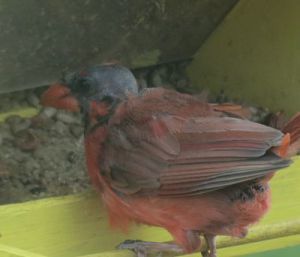
Now, seriously, would you recognize him? I did some further research to learn what caused his “hair” loss, and what his future might hold. His bald head, I discovered, could be due to head mites, which cause incessant scratching and subsequent loss of feathers. Or he could be one of the relatively rare birds who experience complete loss of head feathers during molting season. If the cause was head mites, the prognosis wasn’t great for full recovery of his crowning glory. If his baldness was just his normal molting pattern, he should recover quite well.
I found myself looking out the window more often than usual to catch a glimpse of the bird, to see how he was faring. He seemed to come only in the early morning and evening when there were few others of his kin around—almost as though he were embarrassed by his looks. As one who has suffered more than her fair share of bad hair days, I empathized. As the days and weeks went on, his appearance didn’t change. I showed his photo to family or friends and if they laughed at his odd appearance, I felt quite protective of my feather-challenged friend.
When a pert female cardinal with a very perky crest of her own gave him short shrift one day at the feeder, I was downright indignant. Didn’t he deserve love, a family, respect from his fellow birds, no matter what he looked like? I did additional online research to see if there was something I could do, some kind of special feed, maybe, that might speed his feather regrowth.
It appeared there was nothing to be done but wait and see, which as a recovering rescuer, I find exceedingly hard to do. I want to fix every problem I find, whether mine or anyone else’s–regardless of whether they want them fixed or not. Then, about a week ago, I caught a glimpse of him that showed me he was clearly on the road to regrowth. 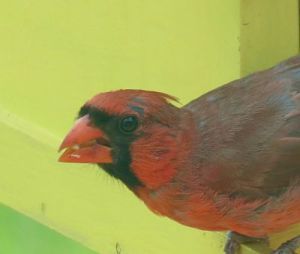
Finally, today, he posed quite jauntily at the feeder and it appears he’s well on his way to a full crest again. Reminding me that sometimes all you can do is wait, and sometimes, that’s all you need to do. A valuable lesson for cardinals, and for people, too.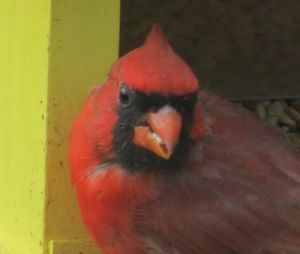

August 18, 2016
Drawing on Imagination

Art illustrates life
Not long ago I watched video of an Olympic cyclist who crossed the finish line to win a gold medal. As she came within a few hundred meters of her goal, she pushed harder and harder, throwing every fiber of her being into the effort to complete her race. She allowed no distractions, no anxieties, nothing to stand in her way. She reached her goal, then immediately collapsed in a heap. I felt admiration for her, but not kinship.
As I come within the writing equivalent of the finish line, I find myself not pushing, pushing, pushing with the last full measure of strength, but instead looking for ways to avoid those last hard yards to completion. And I am now going to share one of the distractions I discovered with you.
In Dangerous Places, Leah Nash, my main character, has moved into a new loft apartment in downtown Himmel—though that’s not one of the dangerous places. Although I’ve described it in detail in the book, I began to think it might be fun to have a sketch of her new surroundings to include on my website. Because my drawing abilities atrophied somewhere around second grade, I knew that it would not be me converting words to pictures.
Luckily, artist Melanie Lewis agreed to do a couple of illustrations for me. Equally lucky for an introvert like me, Melanie is not only a friend, she’s also a neighbor. My quest required nothing more than a few steps and a one-on-one conversation.
For a few days after that, instead of forging ahead with the conclusion of my mystery novel, I had way too much fun working with Melanie to make my imaginary world seem a little more real. I think she did a great job bringing Leah’s setting to life.
Here is the block in Himmel where Leah now lives. The top floor of the building second from the left is her apartment.

Leah’s street–Himmel, WI
And here is the living room of Leah’s loft apartment.
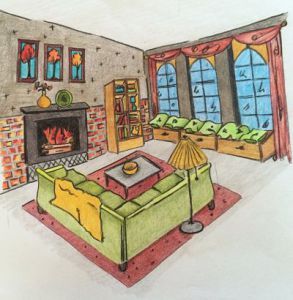
Leah’s loft apartment
The drawings are now posted on my web site, under the header Leah’s World. There’s already a map of Himmel and of DeMoss Academy, a primary setting in the first book, Dangerous Habits, posted there.
Although I’d like to spend some time stretched out on Leah’s window seat looking down at the goings on in the town of Himmel below, it really is time to get back up on my metaphorical bicycle and pedal my way to the finish line. Where I will no doubt collapse in a dead faint upon arrival.





